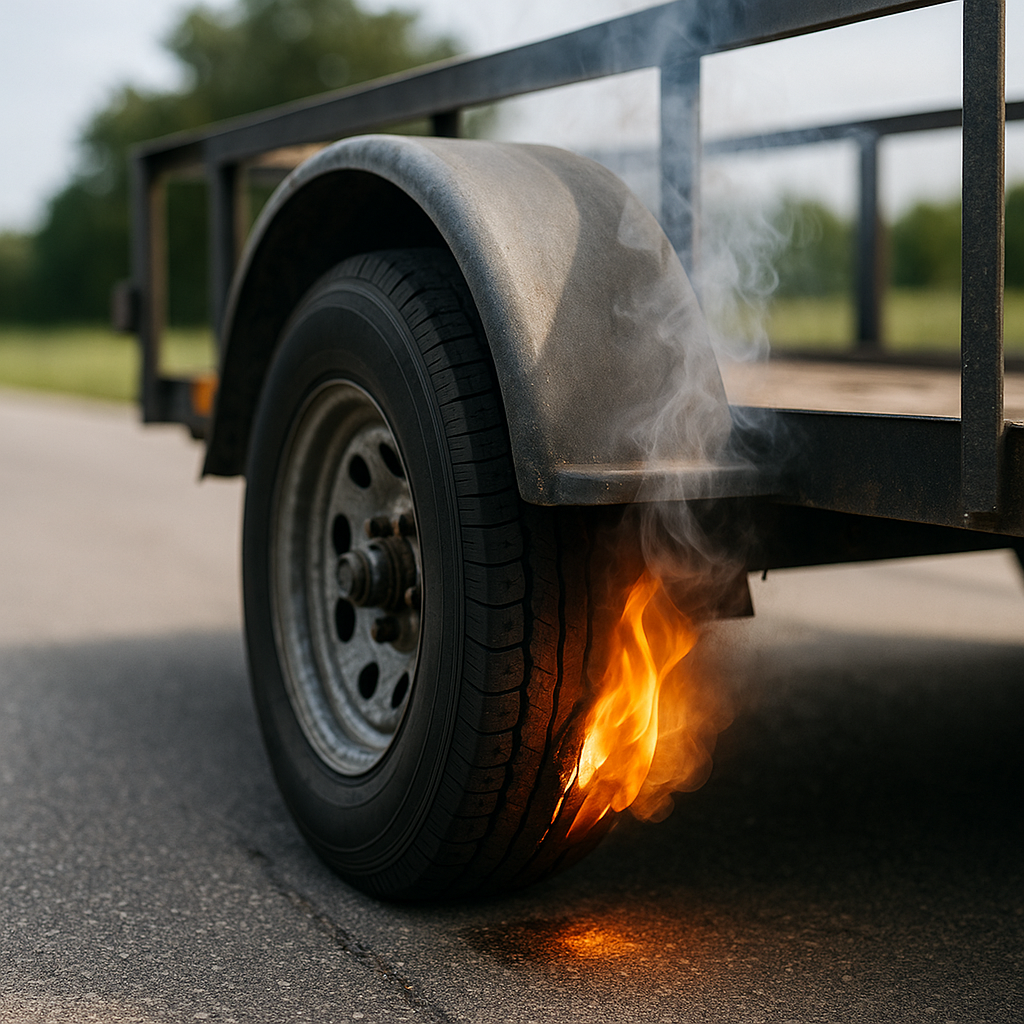In the world of towing and trailer safety, understanding the importance of a trailer tire monitor can be a game changer. These advanced systems are designed to provide real-time data on tire pressure and temperature, which are critical factors in maintaining optimal performance and safety. Failing to monitor these elements can lead to catastrophic failures, such as blowouts, which can result in accidents and costly damages.
Here are some key reasons why investing in a trailer tire monitor is essential:
- Preventative Safety: Regular monitoring allows for early detection of potential issues, helping to avoid dangerous situations on the road.
- Enhanced Longevity: Proper tire maintenance through monitoring can extend the lifespan of your tires, saving you money in the long run.
- Improved Fuel Efficiency: Maintaining optimal tire pressure can enhance fuel efficiency, leading to reduced operational costs.
- Increased Confidence: Knowing that your trailer is equipped with a reliable monitoring system provides peace of mind while towing.
Incorporating a trailer tire monitor into your towing setup is not just an upgrade; it’s a necessity for ensuring safety and efficiency on the road. Tow with peace of mind, knowing that trailerwatchdog is standing guard. Visit trailerwatchdog.com today to learn more about how we can protect your towing experience.
How Trailer Tire Monitors Work for Safety
Understanding how trailer tire monitors function is pivotal to appreciating their role in ensuring safety while towing. These systems utilize a combination of sensors, wireless technology, and data analytics to provide real-time information about tire conditions.
At the core of a trailer tire monitor are specialized sensors that are mounted directly on the tires or within the valve stems. These sensors continuously measure:
- Tire Pressure: Maintaining the correct tire pressure is crucial for safe towing. The sensors alert the user when pressure drops below a certain threshold, preventing underinflation and potential blowouts.
- Tire Temperature: Excessive heat can indicate problems like overloading or underinflation. By monitoring tire temperature, the system can warn of potential failures before they occur.
Data collected by these sensors is transmitted wirelessly to a display unit located inside the towing vehicle. This display provides real-time updates, allowing the driver to monitor the status of each tire easily. Additionally, many modern systems can send notifications directly to smartphones, ensuring that drivers remain informed even when they are not inside the vehicle.
The integration of these technologies helps drivers make informed decisions, such as when to pull over for adjustments or repairs. By being proactive about tire health, drivers can significantly reduce the risk of accidents, ensuring a safer journey for everyone on the road.
Types of Trailer Tire Monitoring Systems Available

When it comes to choosing a trailer tire monitor, understanding the various types available can help you select the system that best suits your needs. Here are the primary categories of tire monitoring systems:
- Direct Tire Pressure Monitoring Systems (TPMS): These systems feature sensors mounted directly onto each tire, measuring pressure and temperature in real-time. They provide accurate readings and can alert drivers immediately if tire conditions change. Direct TPMS systems are often favored for their precision and reliability.
- Indirect TPMS: Instead of using sensors, indirect systems rely on the vehicle's ABS (Anti-lock Braking System) to monitor changes in wheel rotation speed. If a tire is underinflated, it rotates at a different speed than the others, triggering an alert. While typically less expensive, indirect systems may not provide real-time pressure readings.
- Smart Tire Monitoring Systems: These advanced systems integrate with mobile apps, offering features like remote monitoring, historical data tracking, and alerts sent directly to your smartphone. Smart systems are ideal for tech-savvy users who appreciate additional insights into their trailer's performance.
- Bluetooth Tire Monitors: These systems utilize Bluetooth technology to connect tire sensors to a smartphone app. They are often user-friendly and allow for easy setup and monitoring. However, they may have limitations in range and data updates compared to more robust systems.
Each type of trailer tire monitoring system offers distinct advantages and challenges. When selecting a system, consider factors like your towing frequency, budget, and how much data you want to access while on the road.
Key Features to Look for in Tire Monitors

When investing in a trailer tire monitor, certain key features can significantly enhance the system's effectiveness and overall user experience. Here are some essential features to consider:
- Real-Time Monitoring: Look for systems that provide continuous, real-time updates on tire pressure and temperature. This feature allows for immediate awareness of any issues, enabling timely action to prevent potential failures.
- Alerts and Notifications: Choose a monitor that offers customizable alerts for both pressure and temperature anomalies. Notifications can come through various channels, including audible alarms or smartphone alerts, ensuring you stay informed while on the road.
- Multi-Tire Capability: If you have a multi-axle trailer, select a system that can monitor multiple tires simultaneously. This is particularly important for ensuring comprehensive safety across all tires, especially during long hauls.
- Durability: Given the harsh conditions that trailers often encounter, durability is crucial. Look for monitors that are weatherproof and resistant to vibrations, ensuring they can withstand the rigors of the road.
- User-Friendly Interface: Opt for systems with easy-to-navigate interfaces, whether on a dedicated display or a smartphone app. A clear and intuitive interface can make it simpler to access vital information quickly.
- Battery Life: Long battery life is essential, especially for wireless systems. Check reviews and specifications to find monitors that offer extended battery performance, minimizing the need for frequent replacements.
By prioritizing these features, you can ensure that your tire monitor not only meets your needs but also enhances your safety and peace of mind while towing.
Installation Tips for Effective Tire Monitoring

Proper installation of your trailer tire monitor is crucial for effective performance and accurate readings. Here are some essential tips to ensure a successful installation:
- Read the Manual: Before starting, thoroughly review the manufacturer’s manual. Each system may have specific installation procedures and requirements that are important for optimal functioning.
- Choose the Right Location: For sensors, select locations that are accessible and protected from potential damage. Avoid areas that might be exposed to excessive heat or moisture, as this can affect the sensors’ performance.
- Ensure Proper Alignment: When attaching sensors, make sure they are aligned correctly to the tire’s valve stem. Misalignment can lead to inaccurate pressure readings, hindering the monitor's effectiveness.
- Connect to Power Source: For systems that require a power connection, ensure you connect them to a reliable power source. Double-check your connections to prevent power loss during use.
- Test the System: After installation, conduct a thorough test of the system. Check if the monitor accurately reflects tire pressure and temperature readings. This step is vital to confirm that everything is functioning as intended.
- Regular Maintenance: Once installed, schedule regular checks to ensure the system remains in good working order. Look for any signs of wear, and replace batteries or sensors as needed.
By following these installation tips, you can enhance the reliability of your tire monitoring system, ensuring a safer towing experience.
Maintenance Best Practices for Trailer Tire Monitors

To maximize the lifespan and effectiveness of your trailer tire monitor, regular maintenance is essential. Here are some best practices to keep your system performing optimally:
- Regular Battery Checks: Ensure that the batteries in your tire monitor are checked periodically. Low battery power can lead to inaccurate readings. Replace batteries as recommended by the manufacturer.
- Calibration: Many tire monitoring systems require periodic calibration to ensure accuracy. Follow the manufacturer’s guidelines for recalibrating your monitor to maintain precise readings.
- Inspect Sensors and Connections: Regularly examine the sensors and wiring for any signs of damage or wear. Ensure all connections are secure and free from corrosion, as this can impact the performance of the system.
- Software Updates: Check for software updates for your tire monitoring system. Manufacturers often release updates that can improve functionality and provide new features.
- Cleanliness: Keep the sensors and the area around them clean and free from debris. Dust and grime can obstruct readings and lead to malfunctions.
- Monitor Performance: Keep an eye on the tire monitor’s performance. If you notice any discrepancies in readings, address them promptly to avoid potential issues.
By following these maintenance best practices, you can ensure your trailer tire monitor remains a reliable tool for safety on the road. Tow with peace of mind, knowing that trailerwatchdog is standing guard. Visit trailerwatchdog.com for more information on how we can help you keep your trailer safe.








